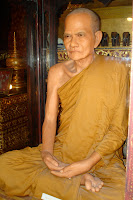It was renovated last year and has the crispness of new construction around it. It is the home of a Standing Buddha, and the Abbot of the monastery died just last year at age 91. His funeral was on Monday, just before we got there.

Yup. This revered monk died a year ago, remained in state for a year and was cremated on Monday.
On the grounds, and apparently with much pomp and circumstance.
Tuu explained that it had just happened a few days earlier, but we didn’t comprehend until someone we met later that it had, in fact, JUST happened the day before.
On the grounds, there is a concrete form set up It was there still, and looked to be a little larger than a concrete grave liner that we’d see in the US, except it sat above the ground. There were ashes all around. If we understand it correctly, there’s a big ceremony – we saw pictures from one guy who was there of a full sized paper mache elephant, which in Buddhist belief transports the monk’s soul to heaven. (If it were a member of the royal family, it would be a swan). There were fireworks, music, chanting and a lot of show.
And we missed it.
There were several Novice Monks (young boys, between about 12 and 16) who were picking through the ashes, we were told looking for nails. Never quite got a grasp on that.
 The ashes of the monk, being considered holy relics, will be put in a Stupa. Thai do not do in-ground burial because (a) land is too expensive and (b) the first Buddha was cremated.
The ashes of the monk, being considered holy relics, will be put in a Stupa. Thai do not do in-ground burial because (a) land is too expensive and (b) the first Buddha was cremated.At this temple and at several others, we saw wax replicas of famous monks. They’re pretty amazing, and if you didn’t know they were wax you’d swear the person was sitting there in front of you. There are also bronze (?) statues of other abbots and monks who are revered, and you can attach a piece of gold leaf about 1 ½ inches square to the statue as a sign of respect.
The temple renovation cost about 30 Million Baht ($918,000 US), of which half the money came from the king and half came from the local congregation.
The main Pagoda of the temple was built in 1401 but has had to be abandoned. It is 36 meters high (117 ft.) and has 28 elephants around it, but is no longer structurally sound due to earthquake damage.
There are several Buddha that are important at this temple. One is the Reclining Buddha, which has two Burmese Buddha’s with it, and then next to that is a Chinese Buddha – they’re always fat, reflecting wealth, good health and happiness. Burmese Buddha tend to have red painted lips on them, regardless of however else they are ornamented.
The Buddhist temples always seem to recognize and respect other religions, or differences in beliefs even within their own religion. You’ll see statues from different cultures side by side, or paintings that are in different styles, especially if they are from different time periods, when one culture might be more predominant.








No comments:
Post a Comment